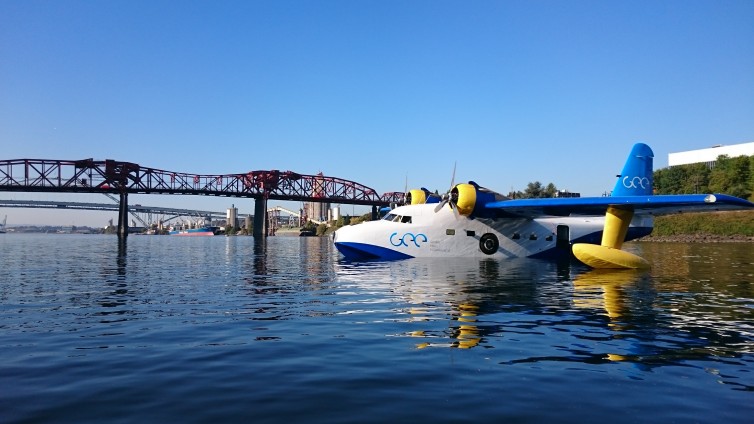
The vintage 1952 Grumman Albatross – Photo: Jason Rabinowitz
“Do you have time this week for a flight in a 1952…”
’œYes.’
’œWhat time do you have ava’¦’¦’
’œI’ll make time available. Just grab me a seat!’
That’s pretty much the conversation I had prior to the 2015 APEX Expo, where Global Eagle subsidiary Row 44 had its Grumman Albatross on hand to give demo flights throughout the week. Naturally, when offered the chance to hop on board for one of the flights, I made it my business to be available.
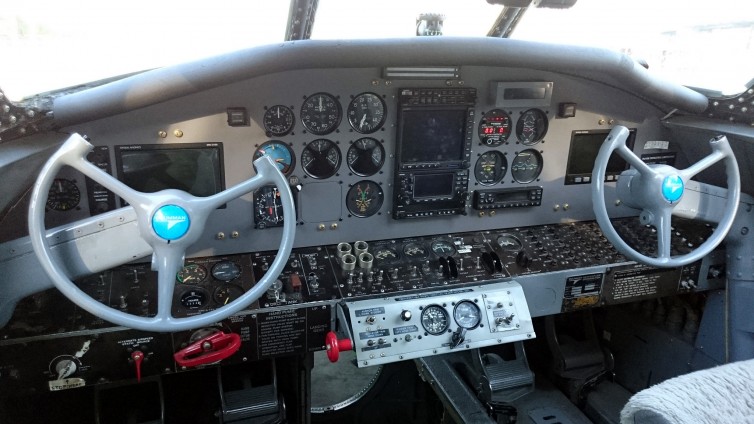
The classic controls – Photo: Jason Rabinowitz
Global Eagle is the in-flight internet provider to a few major airlines in the United States, including Southwest Airlines. While its satellite equipment is installed on hundreds of commercial aircraft, an aircraft it can call its own is necessary to constantly test the service and upcoming products. While our friends at Gogo now have a 737 to call their own, Global Eagle kind of went the other way on this one. Its test aircraft is this wonderful old Albatross. What better way to test the future of in-flight connectivity than with a half century old twin’“radial engine amphibious flying boat?
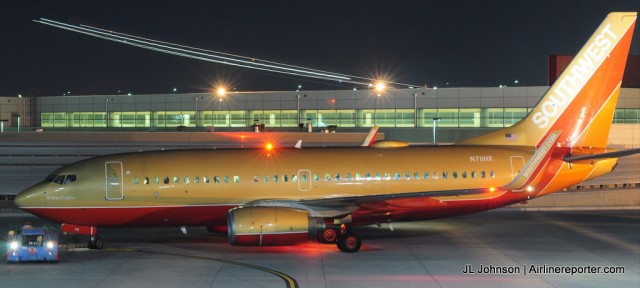
Southwest 737-700 (N711HK) seen at Dallas Love Field with Row 44 raydome between the strobe and vertical stabilizer. It also sports a retro-livery design.
On November 20, 2013 Southwest Airlines announced that, effective immediately, customers could use their portable electronic devices (PEDs) gate-to-gate. This was expected as other airlines had been making similar announcements earlier in the month after the FAA relaxed their rules. What wasn’t expected was that in-flight entertainment (IFE), through their Row 44 WiFi, would also be available gate-to-gate, making them the first U.S. airline to offer a seamless integrated experience, regardless of altitude.
Southwest Airlines has long been a renegade, going against the grain, often being successful with that strategy. When the industry zigs, they zag and usually find themselves with a competitive advantage. And that’s exactly what they did when they bucked the trend of U.S. airlines signing on with traditional passenger-level-hardware IFE. Instead, Southwest chose Row 44, an industry underdog to provide their connectivity. Row 44’s network is powered solely by satellite, whereas (at the time) the other big domestic players (i.e. GoGo) focused on terrestrial (land-based cell tower) service.
BONUS: GoGo Unveils New In-Flight Technology
I’m a known critic of IFE at the airline-provided-hardware level. I am of the school of thought that if you can give me WiFi, I’ll find a way to entertain myself, with my own device(s). BYOD (that is, “bring your own device”) is gaining in popularity across many industries and applications, so why not with airlines? Traditional IFE is expensive to implement, heavy to fly around, and requires added maintenance. With passengers likely to bring the added weight of their own devices anyway, why not simply eliminate the cost and complexity?
Southwest’s in-flight connectivity is nothing new, but has matured well beyond basic WiFi. I recently had the opportunity to try out the new gate-to-gate, or in my case, gate-to-gate-to-gate Row 44 on a business trip from Kansas City with a stopover at Dallas Love Field on my way to San Antonio. Let me say, I was impressed.
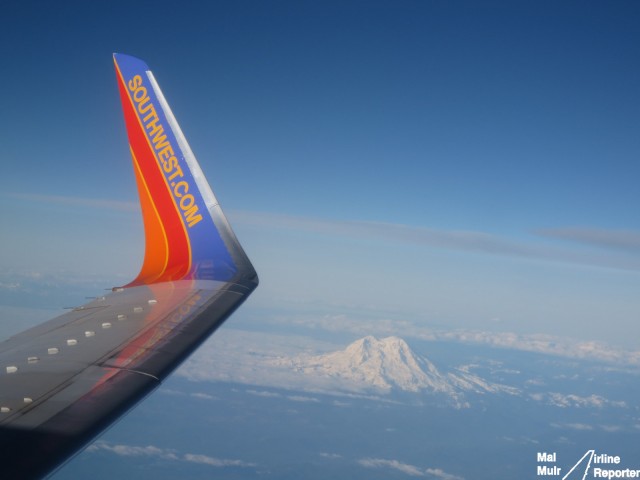
Passing Mt Rainier on-board a Southwest Airlines 737.
When I wanted to get between Seattle (SEA) and San Jose (SJC) via a direct flight, I didn’t have too many choices. I could have either flown on Alaska or Southwest Airlines. Since I had never flown Southwest before, I decided to give it a try and tick a new airline off my list.
The whole experience began the day before my flight when it was time to check in. I had read a few guides (although not the one written by the founder of this very website — oops) on how to deal with a Southwest flight.
Southwest, unlike any airline I had ever flown before, does not assign seating — it is a ’œFree for all’. Your ticket simply lists your boarding group (A, B or C) and a number which is your place in line. When you get on-board you are free to sit wherever you want.
The first 15 in the A group are reserved for Southwest’s frequent flyers or ’œA listers’. Some fare classes and those who pay for automatic early check-in [aka EarlyBird] snag the majority of the A group. The first 60 guests get the A group, the next 60 get B and whatever is leftover gets C. You obviously don’t want to be in the C group, if you don’t like middle seats. I luckily scored an A group ticket — game on.
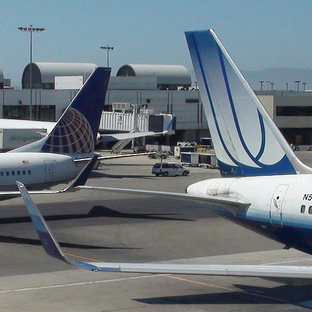
Two will enter, one will leave. Some will have Wi-Fi.
United has announced today that Continental intends to add Wi-Fi to 200 of their Boeing 737 and 757 aircraft. It is not officially, official that this will happen, but I would imagine it will go through.
If you get confused on who and what United and Continental Airlines are right now, you are not alone. Although they will be merging, they are still two separate airlines. This gets more confusing since they have started to re-paint planes and doing joint announcements.
Add to the confusion that currently, United flies fourteen aircraft with Wi-Fi already on their Premium Service (PS). 13 of those aircraft are using Go-Go Inflight Wi-Fi and one is using Row 44. The Continental aircraft will be using LiveTV’s ViaSat-1 satellite internet. Those are a lot of different providers and I would imagine as the merger settles down, the new United will be looking at which service package they would want to provide to the entire fleet. Since the new United has so many international destinations, it makes sense for them to look at using a satellite provider like Row44 or LiveTV.
Becoming the world’s largest airline is not easy. There are a lot of things that still need to be dealt with to make sure the new United has a consistent brand.Time is of the essence since the new United doesn’t want to alienate loyal customers for both airlines during the transition.
To learn a bit more, check out my story on AOL Travel News.

We can do silly things to get that internet!
On the ground we live in a world of easy communication. Access to the internet is pretty much everywhere, from Wi-Fi, to phones, to city-wide free wireless access. However, the technology has seemed to take a while to find a foot hold in the sky.
It would seem to make sense. People are willing to pay to use the internet at hotspots on the ground (even at the airports) why hasn’t the technology taken off (heh) in the air?
Connexion by Boeing used to be the beacon of hope. Here was a big name (you probably have heard of Boeing if you are reading this blog) that was to provide internet access to passengers on planes. It went online on May 17, 2004 and only lasted until December 31, 2006. Boeing stated, “the market for this service has not materialized as had been expected.”
Prices varied from $9.95 per hour to $29.95 for unlimited access. Even though this might be a little too pricey for some, it would seem cheap enough to provide enough entertainment, communication, and business productivity for those who are dropping at least a few hundred on a ticket.
So, where is the beacon of hope now? One of the brightest beacons is Row 44. It was also created in 2004 around the same time as Connexion, but unlike Boeing it is still around and with a hopeful future.
Row 44 currently has plans to set up trial runs on Alaska Airlines and Southwest Airlines. Unfortunately there was been a little delay due to competition for FCC approval. However they are on track now for testing to start in early 2009. The beauty for those of us in North America, is we might have a chance to use the system (Connexion was not in N. America).
One way or another, I have faith that sometime in the near future we will have seamless internet connection from the ground into the air. Many people have already made it clear they don’t want to be sitting next to someone for a few hours talking on their cell phone (including myself), but I know I would love to be entertained (and gosh maybe even write an airline blog) at 30,000 feet in the air.
Image: Juicyrai





